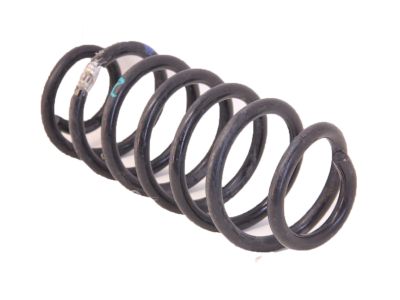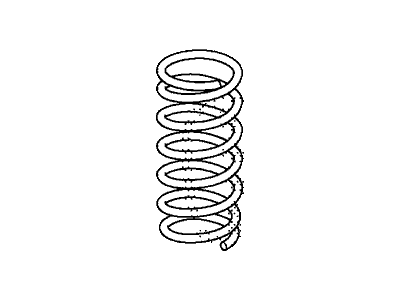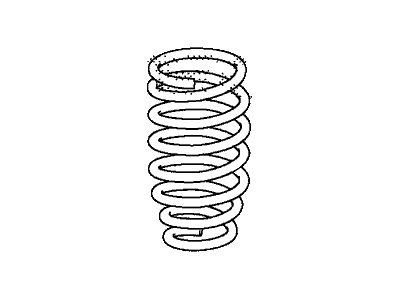×
- Hello
- Login or Register
- Quick Links
- Live Chat
- Track Order
- Parts Availability
- RMA
- Help Center
- Contact Us
- Shop for
- Honda Parts
- Honda Accessories

My Garage
My Account
Cart
Genuine Honda Crosstour Coil Springs
Strut Spring- Select Vehicle by Model
- Select Vehicle by VIN
Select Vehicle by Model
orMake
Model
Year
Select Vehicle by VIN
For the most accurate results, select vehicle by your VIN (Vehicle Identification Number).
11 Coil Springs found
Honda Crosstour Coil Springs
Coil Springs in Honda Crosstour vehicles is used mainly in the support of the weight of the vehicles and shock absorptions of the bumps on the road. Wear of coil springs is characterized by symptoms that includes sagging or bottoming out of the vehicle, or abnormal wear of tires. Coil springs for the vehicle are available in the market to replace the worn out ones so as to maintain the ride height and quality, and for additional load the variable rate or cargo coils can be used. These springs are available in different heights and spring rates whereby you can get a lift and lowering kit, performance as well as adjustable coilovers for the fine-tuning of the car's ride height. Linear rate, progressive and dual rate springs are the common kinds of the coil springs which provide varying rates of stiffness and compression to enhance the car stability and reduce the likelihood of bottoming.
In search of affordable OEM Honda Crosstour Coil Springs? Consider browsing through our extensive inventory of genuine Honda Crosstour Coil Springs. Not only do we provide market-leading prices and a manufacturer's warranty, but we also pride ourselves on exceptional customer service and swift delivery.
Honda Crosstour Coil Springs Parts Questions & Experts Answers
- Q: How to replace shock absorbers or coil springs for the Honda Crosstour?A:If the shocks or coil springs exhibit the telltale signs of wear (leaking fluid, loss of damping capability, chipped, sagging or cracked coilsprings) explore all options before beginning any work. The shock absorbers or coil springs are not serviceable individually and must be replaced if a problem develops. However, complete assemblies may be available on an exchange basis, which eliminates much time and work. Whichever route you choose to take, check on the cost and availability of parts before disassembling your vehicle. Remove the shock absorber/coil spring assembly. Mount the shock/coil spring assembly in a vise. Line the vise jaws with wood or rags to prevent damage to the unit and don't lighten the vise excessively. Following the tool manufacturer's instructions, install the spring compressor (which can be obtained at most auto parts stores or equipment yards on a daily rental basis) on the spring and compress it sufficiently to relieve all pressure from the upper spring seat. This can be verified by wiggling the spring. Note the orientation of the upper mount in relation to the lower mounting eye. Make a sketch or some matchmarks to help you get the mount positioned properly when reinstalling it. Hold the shock damper rod with an Allen wrench, and unscrew the retaining nut with a box-end wrench. Disassemble the parts from the damper, taking care to lay the parts out in the exact order in which they are removed. Reassembly is the reverse of removal, noting the following points: Carefully place the spring onto the shock absorber body, with the end of the spring resting in the lowest part of the seat. Use a new self-locking nut, then lighten the nut. Before releasing the spring compressor, make sure the upper mount is oriented as it was before removal. After removing the spring compressor tool, the unit is ready for installation.
- Q: How to remove and install a front shock absorber and coil spring assembly for the Honda Crosstour?A:Loosen the wheel lug nuts, raise the vehicle and support it securely on jackstands. Remove the wheel. Place a floor jack under the lower Control Arm to support it. Remove the damper fork-to-shock pinch bolt. Remove the damper fork-to-lower control arm bolt and remove the fork. It may be necessary to tap the fork from the shock absorber. Support the shock absorber and coil spring assembly and remove the five upper mounting nuts. Carefully remove the unit from the fenderwell. Guide the shock absorber assembly up into the fenderwell and insert the five upper mounting studs through the holes in the body. Once the studs protrude from the holes, install the nuts so the assembly won't fall back through, but don't tighten the nuts completely yet. The shock absorber is heavy and awkward, so get an assistant to help you, if possible. Insert the lower end of the shock absorber into the damper fork. Caution: Make sure the aligning tab on the back of the shock body enters the slot in the damper fork. Connect the damper fork to the lower control arm, using a new nut on the damper fork bolt. Raise the lower control arm with a floor jack to simulate normal ride height, then tighten the damper fork pinch bolt and damper fork-to-lower control arm bolt nut. Install the wheel and lug nuts, lower the vehicle and tighten the lug nuts. Tighten the upper mounting nuts.
- Q: How to remove and install the rear shock absorber and coil spring assembly for the Honda Crosstour?A:Loosen the rear wheel lug nuts, raise the vehicle, place it securely on jackstands and remove the rear wheels. Remove the rear package shelf trim cover. Remove the seat back side trim panel. Note: This step applies to sedans only. Remove the shock absorber upper mounting nuts. Remove the nut from the upper end of the stabilizer link. Remove the shock absorber lower mounting bolt. Pull the rear knuckle down and remove the shock absorber/coil spring assembly. To inspect or replace the shock absorber or coil spring, proceed accordingly. Installation is the reverse of removal, noting the following points: Raise the rear knuckle with a floor jack to simulate normal ride height before tightening the shock absorber lower mounting bolt. Tighten the upper mounting nuts. Tighten the wheel lug nuts.














